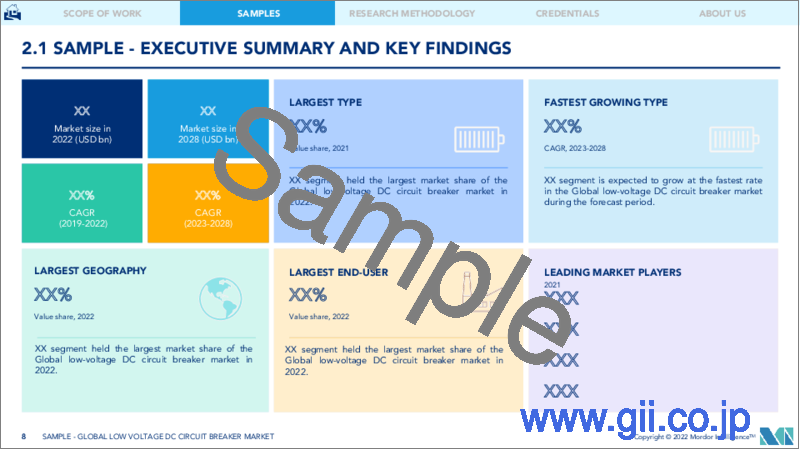|
|
市場調査レポート
商品コード
1138621
低電圧直流遮断器市場- 成長、動向、予測(2022年~2027年)Low Voltage DC Circuit Breaker Market - Growth, Trends, and Forecasts (2022 - 2027) |
||||||
|
● お客様のご希望に応じて、既存データの加工や未掲載情報(例:国別セグメント)の追加などの対応が可能です。 詳細はお問い合わせください。 |
|||||||
| 低電圧直流遮断器市場- 成長、動向、予測(2022年~2027年) |
|
出版日: 2022年10月13日
発行: Mordor Intelligence
ページ情報: 英文 105 Pages
納期: 2~3営業日
|
- 全表示
- 概要
- 目次
低電圧直流遮断器の世界市場は、2022年から2027年にかけてCAGR3.25%以上を記録し、2027年の市場規模は24億5000万米ドルに達すると予測されています。
COVID-19の大流行が低電圧直流遮断器市場にマイナスの影響を与えました。米国では、2020年第1四半期から第2四半期にかけて、新規PV設置数が23%減少しました。直流回路ブレーカは、直流と交流の間の障壁として機能する太陽光発電システムの必須コンポーネントであるため、太陽光発電の設置数の減少は、パンデミックに伴い市場の成長を停止させました。電力消費量の増加、エネルギーミックスにおける再生可能エネルギーの流入、データセンターや電気自動車の増加といった要因が、予測期間中の市場の牽引役となることが予想されます。しかし、電力供給の安定性が増し、サーキットブレーカの必要性が低下していることが、今後数年間、低電圧直流サーキットブレーカ市場の成長を抑制する可能性があります。
*太陽エネルギー分野は、実用規模の太陽光発電所への投資の増加により、予測期間中に最も急成長する市場であると予想されます。
*世界的に、クリーンエネルギー事業への投資や再生可能エネルギーの開発に重点が置かれるようになりました。その結果、新たな再生可能プロジェクトの広範な開拓と電力使用量の増加が、今後低電圧直流遮断器市場に優れた機会をもたらすと思われます。
*アジア太平洋地域は近年、低電圧DCサーキットブレーカー市場を独占しており、予測期間においても、需要の大部分が中国、日本、韓国、インドからもたらされ、著しい成長を示すことが期待されています。
主な市場動向
太陽エネルギー分野が市場を席巻
*低電圧DCサーキットブレーカは、太陽エネルギー分野が予測期間中に最も急成長する市場であると予想されます。低電圧直流遮断器は、小規模および公益事業規模の太陽光発電プロジェクトにおいて、故障した太陽光発電パネルを切り離すために使用されます。
*設置容量の大部分は実用規模の太陽光発電所の形で追加され、そのすべてが直流回路ブレーカーを使用して「ファーストフォルト」状態に対応しています。これは、最初の意図しないアースへの接続に相当し、負荷条件下で直流回路ブレーカーがインバータから太陽光発電配列を安全に切り離すときのことです。
*太陽光発電協会によると、2020年7月に建設中および開発中の太陽光発電プロジェクトは、約115GWありました。これらのプロジェクトの建設は、低圧回路ブレーカー市場の大きな促進要因になると予想されます。北米と欧州の先進諸国とアジア太平洋の新興諸国は、太陽光発電の主要なホットスポットであり、ひいてはこの分野における低電圧直流回路ブレーカーも注目されています。
*さらに、太陽光発電プロジェクトのデベロッパーは、2020年から2023年の間に、米国で3,616MWの大規模蓄電池を稼働させる計画であると報告しています。このため、同国の電池エネルギー貯蔵プロジェクト全体の増加は、低圧直流遮断器システム市場の需要を押し上げると予想されます。
*クリーンエネルギーに対する需要の増加は、太陽エネルギー部門、ひいては同部門の直流遮断器の主要な促進要因の1つです。したがって、クリーンエネルギー需要の増加に伴い、太陽エネルギー部門は成長し、太陽エネルギー部門における低電圧直流遮断器市場を後押しすると予想されます。
アジア太平洋地域が市場を独占
*アジア太平洋地域は、人口増加、都市化、工業化により、最も急速に成長している市場の1つです。その結果、クリーンエネルギーへの需要が高まり、近い将来、低電圧直流遮断器の需要が高まると予想されます。
*2020年3月、新・再生可能エネルギー省傘下の中央公営企業(CPSU)であるインド太陽エネルギー公社(SECI)は、商業運転を開始し、10年間で500万kWの太陽光-風力-蓄電ハイブリッド容量を設置する計画を発表しています。同公社は、今後2年間で5,000MWの容量のうち500MWを約2,800カロールインドルピーで設置する計画で、この地域の低圧直流遮断器市場の成長を支えることになります。
*さらに、インドでは蓄電池を備えた太陽光発電プロジェクトが徐々に普及しつつあります。過去にSECIは、太陽光発電プロジェクトにBESSを組み込んだ入札を数件発表しています。2020年9月、SECIはチャッティースガル州で開発される50MW/150MWhのバッテリーエネルギー貯蔵システム(BESS)と共に100MW(AC)の太陽光発電プロジェクトの入札を発表しました。2020年1月には、SECIがアンダマンで2MWのバッテリーエネルギー貯蔵システムとともに4MWの系統連系浮体式太陽光発電プロジェクトを立ち上げるための入札を実施しました。このため、蓄電システムの増加により、低圧直流遮断器の需要が増加する可能性が高いです。
*さらに、中国政府は2020年に新エネルギー車(NEV)のシェア 12%を義務付けることを決定しています。乗用車の総販売台数のうち、中国以外のブランドが占める割合は約50%。また、中国企業との合弁会社による中国国内での生産が大半を占めています。
*これらの要因が、予測期間中に同地域の低電圧直流遮断器の需要を促進する可能性があります。
競合情勢
直流低圧ブレーカー市場は断片的です。この市場の主要企業には、ABB Ltd、Larsen &Toubro Limited、三菱電機株式会社、富士電機株式会社、Siemens AGなどが含まれます。
その他の特典
- エクセル形式の市場予測(ME)シート
- アナリストによる3ヶ月間のサポート
目次
第1章 イントロダクション
- 調査対象範囲
- 市場の定義
- 調査の前提
第2章 エグゼクティブサマリー
第3章 調査手法
第4章 市場の概要
- イントロダクション
- 2027年までの市場規模・需要予測(単位:10億米ドル)
- 最近の動向と展開
- 市場力学
- 促進要因
- 抑制要因
- サプライチェーン分析
- ポーターのファイブフォース分析
- 供給企業の交渉力
- 消費者の交渉力
- 新規参入業者の脅威
- 代替品の脅威
- 競争企業間の敵対関係
第5章 市場セグメンテーション
- タイプ
- エアサーキットブレーカー
- モールドケースサーキットブレーカー
- エンドユーザー
- バッテリーシステム
- データセンター
- 太陽エネルギー
- 輸送機器
- その他のエンドユーザー
- 地域別
- 北米
- 欧州
- アジア太平洋地域
- 南米
- 中東・アフリカ
第6章 競合情勢
- M&A、ジョイントベンチャー、コラボレーション、合意書
- 主要なプレーヤーが採用する戦略
- 企業プロファイル
- ABB Ltd
- Hitachi Ltd
- Mitsubishi Electric Corporation
- Larsen & Toubro Limited
- Entec Electric & Electronic Co. Ltd
- CG Power and Industrial Solutions Ltd
- Rockwell Automation Inc.
- Eaton Corporation PLC
- Siemens AG
- Sensata Technologies Holding PLC
- Fuji Electric Co. Ltd
- Schneider Electric SE
- Hyundai Electric & Energy Systems Company
- Powell Industries Inc.
第7章 市場機会と将来動向
The global low voltage DC circuit breaker market is expected to record a CAGR of more than 3.25% over the period of 2022-2027, reaching a market size of USD 2.45 billion by 2027. The COVID-19 pandemic negatively affected the low voltage DC circuit breaker market. The number of new PV installations dropped 23% from Q1 to Q2 2020 in the United States. Since the DC circuit breaker is an essential component of the solar PV system, where it acts as a barrier between direct current and alternating current, the decrease in the number of solar installations halted the market's growth in line with the pandemic. Factors such as an increase in power consumption, the rise of an influx of renewable sources in the energy mix, and a rising number of data centers and electric vehicles are expected to drive the market over the forecast period. However, increased stability of electricity supply, which is reducing the need for circuit breakers, is likely to restrain the growth of the low voltage DC circuit breaker market over the coming years.
* The solar energy sector is expected to be the fastest-growing market during the forecast period, owing to increasing investments in utility-size solar power plants.
* Globally, the focus has increased on investments in clean energy projects and the development of renewable energy. As a result, the extensive development of new renewable projects and growing electricity usage are likely to create an excellent opportunity for the low voltage DC circuit breaker market in the future.
* Asia-Pacific dominated the low voltage DC circuit breaker market in recent years and is expected to witness significant growth in the forecast period, with a majority of the demand coming from China, Japan, South Korea, and India.
Key Market Trends
Solar Energy Sector to Dominate the Market
* The solar energy sector is expected to be the fastest-growing market for low voltage DC circuit breakers over the forecast period. Low voltage circuit breakers are used in both small-scale and utility-size solar projects to isolate faulty solar PV panels.
* A majority of installed capacity was added in the form of utility-scale solar farms, all of which use DC circuit breakers to address "first-fault" conditions, which correspond to the first unintentional connection to the earth, which is when the DC circuit breaker safely disconnects the photovoltaic array from the inverter under load conditions.
* As per the Solar Energy Industries Association, there was nearly 115 GW of under-construction and under-development solar projects in July 2020. The construction of these projects is expected to be a significant driver for the low voltage circuit breakers market. The developed countries of North America and Europe and developing countries of Asia-Pacific are the major hotspots for solar PV and, in turn, low voltage DC circuit breakers in the sector.
* Moreover, solar project developers reported that they have planned to make 3,616 MW of large-scale battery storage operational in the United States between 2020 and 2023. Therefore, an increase in the country's total battery energy storage projects is expected to boost the demand for the low voltage DC circuit breaker systems market.
* Increasing demand for clean energy is one of the primary drivers for the solar energy sector and, in turn, for the DC circuit breakers in the sector. Therefore, with an increase in the demand for clean energy, the solar energy sector is expected to grow and boost the low voltage DC circuit breakers market in the solar energy sector.
Asia-Pacific to Dominate the Market
* Asia-Pacific is one of the fastest-growing markets owing to increasing population, urbanization, and industrialization. As a result, the demand for clean energy is expected to increase, subsequently leading to higher demand for low voltage DC circuit breakers in the near future.
* In March 2020, the Solar Energy Corporation of India (SECI), a central public sector undertaking (CPSU) under the Ministry of New and Renewable Energy, announced that it was planning to enter into commercial operations and set up 5,000 MW of solar-wind-storage hybrid capacity over ten years. The plan of the corporation is to initially set up 500 MW of the 5,000 MW capacity at the cost of about INR 2,800 crore over the next two years, which will, in turn, support the growth of the low voltage DC circuit breaker market in the region.
* Further, solar projects with battery energy storage systems (BEES) are gradually gaining traction in India. In the past, SECI announced a few tenders incorporating BESS with solar projects. In September 2020, SECI announced tenders for a 100 MW (AC) solar power project along with a 50 MW/150 MWh battery energy storage system (BESS) to be developed in Chhattisgarh. In January 2020, SECI issued a tender for setting up 4 MW of grid-connected floating solar projects with 2 MW of battery energy storage system in Andaman. Therefore, an increase in energy storage systems is likely to increase the demand for low voltage DC circuit breakers.
* Moreover, the Chinese government had set 12% of New Energy Vehicles (NEV) share mandates for 2020. Non-Chinese brands account for approximately 50% of the total passenger car sales. Most of these cars are produced in China, in joint ventures (JVs) with Chinese companies.
* These factors are likely to propel the demand for low voltage DC circuit breakers in the region during the forecast period.
Competitive Landscape
The low voltage DC circuit breaker market is fragmented. Some of the key players in this market include ABB Ltd, Larsen & Toubro Limited, Mitsubishi Electric Corporation, Fuji Electric Co. Ltd, and Siemens AG, among others.
Additional Benefits:
- The market estimate (ME) sheet in Excel format
- 3 months of analyst support
TABLE OF CONTENTS
1 INTRODUCTION
- 1.1 Scope of the Study
- 1.2 Market Definition
- 1.3 Study Assumptions
2 EXECUTIVE SUMMARY
3 RESEARCH METHODOLOGY
4 MARKET OVERVIEW
- 4.1 Introduction
- 4.2 Market Size and Demand Forecast in USD billion, till 2027
- 4.3 Recent Trends and Developments
- 4.4 Market Dynamics
- 4.4.1 Drivers
- 4.4.2 Restraints
- 4.5 Supply Chain Analysis
- 4.6 Porter's Five Forces Analysis
- 4.6.1 Bargaining Power of Suppliers
- 4.6.2 Bargaining Power of Consumers
- 4.6.3 Threat of New Entrants
- 4.6.4 Threat of Substitute Products and Services
- 4.6.5 Intensity of Competitive Rivalry
5 MARKET SEGMENTATION
- 5.1 Type
- 5.1.1 Air Circuit Breaker
- 5.1.2 Molded Case Circuit Breaker
- 5.2 End User
- 5.2.1 Battery System
- 5.2.2 Data Centers
- 5.2.3 Solar Energy
- 5.2.4 Transportation
- 5.2.5 Other End Users
- 5.3 Geography
- 5.3.1 North America
- 5.3.2 Europe
- 5.3.3 Asia-Pacific
- 5.3.4 South America
- 5.3.5 Middle-East and Africa
6 COMPETITIVE LANDSCAPE
- 6.1 Mergers and Acquisitions, Joint Ventures, Collaborations, and Agreements
- 6.2 Strategies Adopted by Leading Players
- 6.3 Company Profiles
- 6.3.1 ABB Ltd
- 6.3.2 Hitachi Ltd
- 6.3.3 Mitsubishi Electric Corporation
- 6.3.4 Larsen & Toubro Limited
- 6.3.5 Entec Electric & Electronic Co. Ltd
- 6.3.6 CG Power and Industrial Solutions Ltd
- 6.3.7 Rockwell Automation Inc.
- 6.3.8 Eaton Corporation PLC
- 6.3.9 Siemens AG
- 6.3.10 Sensata Technologies Holding PLC
- 6.3.11 Fuji Electric Co. Ltd
- 6.3.12 Schneider Electric SE
- 6.3.13 Hyundai Electric & Energy Systems Company
- 6.3.14 Powell Industries Inc.




